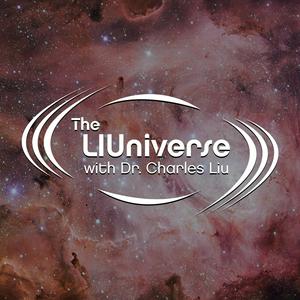Chuck GPT Apocalypse, Part 2
It’s the end of everything! Welcome back to Part 2 of our season finale featuring Dr. Charles Liu, co-host Allen Liu, and our guest archaeology expert and author, Hannah Liu, MEd. (If you haven’t caught up to Part 1, we highly recommend you do before embarking on the next leg of this journey! Listen here or wherever you get your podcasts!)
We pick right up where we left off, with the next question from our audience. Daniela asks, “If a black hole hits the Sun, will Earth be destroyed?” Chuck explains a few ways a black hole can mess with our day, including the fact that long before any actual collision took place, the Sun would start shedding material that would destroy us. He compares that unlikely event to the actual example of cosmic destruction we’re watching in NGC 4676 – aka “The Mice” – which are two galaxies swirling together in a death spiral playing out over hundreds of millions of years.
Naturally, this leads Chuck to ponder what happens when civilizations fall apart here on Earth, and Hannah brings up the collapse of the Roman Empire. As she explains, “the fall of Rome happened a lot of times, and also, no time.” From 44 BCE and the assassination of Julius Caesar, to the 476 invasion and conquest of Rome by the Germanic tribes denoted by Edward Gibbon in The History of the Decline and Fall of the Roman Empire, to the fact ever since nations have claimed to be the descendants or inheritors of Rome.
Chuck points out the influence of Gibbon’s book on Isaac Asimov’s “Foundation” series, followed by a very quick romp through “Decline and Fall of America” literature including The Handmaid’s Tale, A Canticle for Liebowitz, Man in the High Castle, and the zombie apocalypse tour de force, World War Z.
Then it’s time for another question from the audience: Michael says, “I heard that scientists brought back a dire wolf. Could they bring back dinosaurs or animals that could destroy us all?” It turns out, these resurrected animals are just gray wolves that have been engineered to have some characteristics of the extinct predator. It’s still a pretty impressive feat, though, and you’ll hear how they collected bits and pieces of dire wolf DNA to “resurrect them.” Allen also brings up similar modification experiments they’re doing on chickens to make them more dinosaur-like.
Allen points out that bioengineered germs are far more likely to cause our destruction than resurrected dinosaurs, regardless of the world envisioned in the Jurassic Park franchise. And speaking of Michael Crichton, Chuck gives us a breakdown of his sci-fi classic, The Andromeda Strain, about bacteria from space that cause a biological outbreak here on Earth. Hannah points out that historically, some of the biggest killers of human beings have been plagues. She gives us a guided tour of the bubonic plagues, from the Black Death, which may have wiped out as much as 60% of the population of Europe, to the Plague of Justinian a thousand years earlier that killed as many as 100 million people, while also name dropping the Antonine Plague and the Spanish Flu!)
And that’s it Season 4 of The LIUniverse. Stay tuned for Season 5 after the summer.
If you want to find out more about what Hannah’s impending book, check out the Mixed Identity Project
We hope you enjoy this episode, and this season, of The LIUniverse. If you did, please support us on Patreon
Credits for Images Used in this Episode:
NGC 4676, aka “the Mice” are two galaxies swirling together. – Credit: NASA, H. Ford (JHU), G. Illingworth (UCSC/LO), M.Clampin (STScI), G. Hartig (STScI), the ACS Science Team, and ESA; The ACS Science Team: H. Ford, G. Illingworth, M. Clampin, G. Hartig, T. Allen, K. Anderson, F. Bartko, N. Benitez, J. Blakeslee, R. Bouwens, T. Broadhurst, R. Brown, C. Burrows, D. Campbell, E. Cheng, N. Cross, P. Feldman, M. Franx, D. Golimowski, C. Gronwall, R. Kimble, J. Krist, M. Lesser, D. Magee, A. Martel, W. J. McCann, G. Meurer, G. Miley, M. Postman, P. Rosati, M. Sirianni, W. Sparks, P. Sullivan, H. Tran, Z. Tsvetanov, R. White, and R. Woodruff.
Plaster replica of Statue of George Washington by Antonio Canova at the North Carolina Museum of History.– Credit: Creative Commons / RadioFan (talk)
Dire Wolf Cover of TIME magazine, May 12, 2025. – Credit: TIME magazine
Page Museum Display of 404 dire wolf skulls found in the La Brea Tar Pits. – Credit: Creative Commons / Pyry Matikainen
The spread of the Black Death in Europe, 1346-1353. – Credit: Creative Commons / Flappiefh - Own work from: Natural Earth ; Cesana, D.; Benedictow O.J., Bianucci R. (2017).
Yersinia pestis, the bacterium that causes the Plague. Direct Fluorescent Antibody Stain (DFA), 200x. – Credit: CDC 2057 - US Government public domain image, Courtesy of Larry Stauffer, Oregon State Public Health Laboratory
Little Ice Age Temperature Chart. – Credit: Creative Commons / RCraig09 - Own work
#liuniverse #charlesliu #allenliu #hannahliu #sciencepodcast #astronomypodcast #hannahliu #apocalypse #armageddon #doomsday #ngc4676 #themice #blackhole #romanempire #direwolf #bubonicplague #blackdeath #yersiniapestis #theandromedastrain #michaelcrichton #jurassicpark #littleiceage


